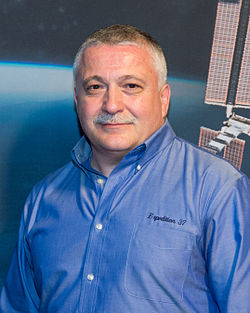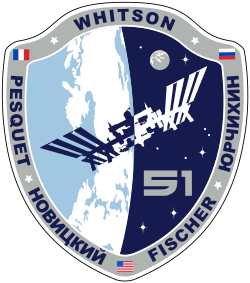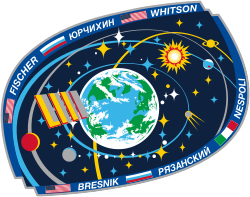Fjodor Nikolajewitsch Jurtschichin
| Fjodor Jurtschichin | |
|---|---|
 | |
| Land | Russland |
| Organisation | Roskosmos |
| Rufzeichen | Олимп („Olymp“)[1] |
| ausgewählt | 28. Juli 1997 |
| Einsätze | 5 Raumflüge |
| Start des ersten Raumflugs | 7. Oktober 2002 |
| Landung des letzten Raumflugs | 3. September 2017 |
| Zeit im Weltraum | 672d 20h 38min |
| EVA-Einsätze | 9 |
| EVA-Gesamtdauer | 59h 28min |
| ausgeschieden | 13. Dezember 2019 |
| Raumflüge | |
Fjodor Nikolajewitsch Jurtschichin (russisch Фёдор Николаевич Юрчихин; * 3. Januar 1959 in Batumi, Adscharische Autonome Sozialistische Sowjetrepublik, Georgische SSR) ist ein ehemaliger russischer Kosmonaut griechischer Abstammung.
Ausbildung
Nach dem Abschluss der Oberschule in Batumi 1976 begann Jurtschichin ein Studium am Moskauer Staatlichen Luftfahrtinstitut. Er beendete sein Studium 1983 mit einem Abschluss in Maschinenbau spezialisiert auf Raumfahrzeuge. 2001 wurde er in Betriebswirtschaft an der Staatlichen Moskauer Verwaltungsuniversität promoviert.
Von 1983 bis 1997 war er Mitarbeiter des russischen Raumfahrtunternehmens RKK Energija. Er arbeitete im Kontrollzentrum, zunächst als Ingenieur, dann als höherer, schließlich als leitender Ingenieur. Schließlich wurde er Chefingenieur für die Mir-Space-Shuttle- und NASA-Mir-Programme.
Kosmonautentätigkeit
Im August 1997 wurde Jurtschichin als Kandidat in der Kosmonautenabteilung von RKK Energija eingeschrieben. Von Januar 1998 bis November 1999 absolvierte er einen Basistrainingskursus und bestand eine Prüfung als Testkosmonaut. Ab Januar 2000 begann er in der Testkosmonautengruppe für das ISS-Programm zu trainieren.
Im Oktober 2002 flog Jurtschichin mit der Raumfähre Atlantis im Rahmen der Mission STS-112 in den Weltraum. Nach Abschluss seines ersten Raumflugs hatte er 10 Tage, 19 Stunden und 58 Minuten im Weltraum verbracht.
Am 7. Mai 2006 wurde er für die Mannschaft von Sojus TMA-10 ausgewählt. Als Sojus-Bordingenieur startete er am 7. April 2007 zur ISS. Dort arbeitete er als Stationskommandant insgesamt 196 Tage. Die Landung am 21. Oktober 2007 in der kasachischen Steppe verlief nicht ganz problemlos, da wahrscheinlich aufgrund eines Computerfehlers der Landepunkt einige hundert Kilometer westlich als vorhergesehen lag.
Im Oktober 2009 wurden die ISS-Besatzungen der Expeditionen 23 bis 27 umgeplant, wodurch Jurtschichin als ISS-Bordingenieur der Expeditionen 24 und 25 nachnominiert wurde. Er war Kommandant des Raumschiffs Sojus TMA-19 und lebte und arbeitete von Juni bis November 2010 an Bord der ISS.[2] Der Start erfolgte am 15. Juni 2010, die Landung am 26. November 2010.
Ab dem 29. Mai 2013 verbrachte Jurtschichin seinen vierten Aufenthalt im Weltraum.[3] Er war Kommandant des Raumschiffes Sojus TMA-09M und blieb sechs Monate an Bord der ISS.[4][5] Am 10. September 2013 übernahm er im Rahmen der ISS-Expedition 37 das Kommando über die ISS, die Rückkehr zur Erde erfolgte am 11. November 2013.
Am 20. April 2017 startete Jurtschichin zu seinem fünften Raumflug. Zusammen mit dem Amerikaner Jack Fischer flog er im Raumschiff Sojus MS-04 zur ISS. Dort arbeitete er zunächst als Bordingenieur der ISS-Expedition 51. Am 2. Juni übernahm er das Kommando der ISS-Expedition 52. Die Landung erfolgte am 3. September 2017.
Zusammenfassung
| Nr. | Mission | Funktion | Flugdatum | Flugdauer |
|---|---|---|---|---|
| 1 | STS-112 | Missionsspezialist | 2002 | 10d 19h 58min |
| 2 | Sojus TMA-10 (ISS 15) | Kommandant | 2007 | 196d 17h 04min |
| 3 | Sojus TMA-19 (ISS 24 & 25) | Kommandant | 2010 | 163d 7h 11min |
| 4 | Sojus TMA-09M (ISS 36 & 37) | Bordingenieur/Kommandant | 2013 | 166d 06h 18min |
| 5 | Sojus MS-04 (ISS 51 & 52) | Bordingenieur/Kommandant | 2017 | 135d 18h 08min |
Privates
Fjodor Jurtschichin entstammt einer griechischstämmigen Familie aus Batumi im heutigen Georgien. Er ist der älteste Sohn von Nikolai Fjodorowitsch Jurtschichin und Mikroula Sofoklewna Jurtschichina (geb. Grammatikopoulou), beides pontische Griechen.[6] Jurtschichin ist verheiratet und hat zwei Töchter.
Siehe auch
Einzelnachweise
- ↑ Позывные экипажей советских/российских космических кораблей. astronaut.ru, 31. Oktober 2010, abgerufen am 21. November 2010 (russisch).
- ↑ NASA and its International Partners Assign Space Station Crews. In: Release 09-233. NASA, 7. Oktober 2009, archiviert vom (nicht mehr online verfügbar) am 3. Februar 2010; abgerufen am 13. Oktober 2009 (englisch). Info: Der Archivlink wurde automatisch eingesetzt und noch nicht geprüft. Bitte prüfe Original- und Archivlink gemäß Anleitung und entferne dann diesen Hinweis.
- ↑ Expressflug geglückt: Astronauten erreichen Raumstation ISS. SpiegelOnline, 29. Mai 2013, abgerufen am 29. Mai 2013.
- ↑ Deutscher ESA-Astronaut Alexander Gerst fliegt 2014 zur Raumstation! ESA, 18. September 2011, abgerufen am 18. September 2011.
- ↑ Планируемые полёты. astronaut.ru, 22. Januar 2012, abgerufen am 23. Januar 2012 (russisch).
- ↑ Russian-Greek cosmonaut Yurchikhin Grammatikopoulos to make 6h space walk. 16. August 2017, abgerufen am 28. Juni 2023 (englisch).
Weblinks
- NASA-Biografie von Fjodor Nikolajewitsch Jurtschichin in der Encyclopedia Astronautica (englisch)
- Kurzbiografie bei spacefacts.de
- Kurzbiografie ( vom 28. Februar 2016 im Internet Archive) bei space.kursknet.ru (englisch)
| Personendaten | |
|---|---|
| NAME | Jurtschichin, Fjodor Nikolajewitsch |
| ALTERNATIVNAMEN | Юрчихин, Фёдор Николаевич (russisch) |
| KURZBESCHREIBUNG | russischer Kosmonaut |
| GEBURTSDATUM | 3. Januar 1959 |
| GEBURTSORT | Batumi, Autonome Republik Adscharien, UdSSR |
Auf dieser Seite verwendete Medien
Following the March 19 Expedition 36/37 (Soyuz 35) press conference, Russian cosmonaut Fyodor Yurchikhin and his two crewmates posed for individual as well as group pictures.
The mission patch design for the 25th Expedition to the International Space Station (ISS) pays tribute to the rich history of innovation and bold engineering in the quest for knowledge, exploration and discovery in space. The patch highlights the symbolic passing of the torch to the ISS, as the vehicle that will carry us into the future of space exploration. The Space Shuttle Program emblem is the foundation of the patch and forms the Greek letter 'Alpha' with a new dawn breaking at the center, symbolizing a new vision for space exploration. The Alpha symbol is overlaid by the Greek letter 'Omega', paying tribute to the culmination of the Space Shuttle Program. The mission designation '25' is shown centered at the bottom of the patch, symbolizing the point in time when the Space Shuttle, the workhorse of the ISS assembly process, will make its final visit to the ISS. Between the '25' and the Earth crescent, the orbiter is shown returning to Earth on its final journey, during the Expedition 25 mission. Above Earth and the breaking dawn, the ISS takes center-stage, completed and fully equipped to carry us beyond this new dawn to new voyages and discoveries. The orbit connecting the ISS and the Earth is drawn in the colors of the United States and Russian flags; paying tribute to the blended heritage of the crew. The two largest stars in the field represent the arrival and departure of the crews in separate Russian Soyuz vehicles. The six stars in the field represent the six crew members. The International Space Station abbreviation 'ISS' and 'MKC' - in English and Russian, respectively - flank the mission number designation, and the names of the crew members in their native languages border the ISS symbol.
Official crew patch of Expedition 51 during their mission to the International Space.
- From as early as the 11th century, coats of arms have been used as emblems representing groups as small as families to as large as countries. The Expedition 51 patch is designed as a modernized international coat of arms, blending the traditional shield shape with our modernized symbol of achievement, the International Space Station. The background represents our home world and its inhabitants on the left, and outer space to the right. The bi-color International Space Station is the bridge between the two, symbolizing the benefits on Earth of space research, and at the same time our mission to explore deeper into space, on a path to further discovery and knowledge.
The Expedition 52 crew insignia
- Our planet is shown surrounded by an imaginary constellation shaped like a house, depicting the theme of the patch: “The Earth is our home.” It is our precious cradle, to be preserved for all future generations. The house of stars just touches the Moon, acknowledging the first steps we have already taken there, while Mars is not far away, just beyond the International Space Station, symbolized by the Roman numeral “LII,” signifying the expedition number.
- The planets Saturn and Jupiter, seen orbiting farther away, symbolize humanity’s exploration of deeper space, which will begin soon. A small Sputnik is seen circling the Earth on the same orbit with the ISS, bridging the beginning of our cosmic quest till now: Expedition 52 will launch in 2017, sixty years after that first satellite.
- Two groups of crew names signify the pair of Soyuz vehicles that will launch the astronauts of Expedition 52 to the Station.
The operational teamwork between human space flight controllers and the on-orbit crew take center stage in this emblem. Against a backdrop familiar to all flight controllers, past and present, independent of any nationality, the fifteenth expedition to the ISS is represented in Roman numeral form as part of the ground track traces emblazoned on the Mercator projection of the home planet Earth. The ISS, shown in its fully operational, assembly complete configuration, unfurls and then reunites the flags of this Russian and American crew in a show of our continuing international cooperation. Golden spheres placed strategically on the ground track near the flight control centers of the United States and Russia serve to symbolize both the joint efforts from each nation's team of flight controllers and the shuttle and Soyuz crew vehicles in their chase orbit as they rendezvous with the ISS. A rising sun provides a classic touch to the emblem signifying the perpetual nature of manned space flight operations and their origin in these two space-faring nations.
The STS-112 emblem symbolizes the ninth assembly mission (9A) to the International Space Station (ISS), a flight which is designed to deliver the Starboard 1 (S1) truss segment. The 30,000 pound truss segment will be lifted to orbit in the payload bay of the Space Shuttle Atlantis and installed using the ISS robotic arm. Three space walks will then be carried out to complete connections between the truss and ISS. Future missions will extend the truss structure to a span of over 350 feet so that it can support the solar arrays and radiators which provide the electrical power and cooling for ISS. The STS-112 emblem depicts ISS from the viewpoint of a departing shuttle, with the installed S1 truss segment outlined in red. A gold trail represents a portion of the Shuttle rendezvous trajectory. Where the trajectory meets ISS, a nine-pointed star represents the combined on-orbit team of six shuttle and three ISS crew members who together will complete the S1 truss installation. The trajectory continues beyond the ISS, ending in a six-pointed star representing the Atlantis and the STS-112 crew.
The dynamic design of the Expedition 36 patch portrays the International Space Station's (ISS) iconic solar arrays. The slanted angles denote a kinetic energy leading from the Earth in the lower right to the upper left tip of the triangular shape of the patch, representing the infinite scientific research, education, and long-duration spaceflight capabilities the ISS provides with each mission, as well as our goal for future exploration beyond the Space Station. The numbers 3 and 6 harmoniously intertwine to form expedition number 36 and its gray coloration signifies the unity and neutrality among all of the international partners of the ISS. The blue and gold color scheme of the patch represents the subtle way the central gold orbit wraps around the number 36 to form a trident at its lower right tip. The trident also symbolizes the sea, air, and land, all of which make up the Earth from where the trident originates in the design.
Leonardo da Vincis vitruvianischer Mensch, erschaffen etwa vor 525 Jahren als eine Mischung aus Kunst und Wissenschaft sowie als Symbol des medizinischen Berufsstandes, wird zwischen den Umlaufbahnen einer Vielzahl von Satelliten dargestellt, die die Erde mit großer Geschwindigkeit umkreisen. Da Vincis Zeichnung, basierend auf den Proportionen eines Mannes, der vom römischen Architekten Vitruv beschrieben wurde, wird oft gebraucht als Symbol der Symmetrie des menschlichen Körpers und des Universums im Allgemeinen. Die nahezu perfekt symmetrische Internationale Raumstation mit ihren ausgebreiteten Sonnensegeln und beleuchtet von den ersten Strahlen des Sonnenaufgangs ist abgebildet als mächtiges Leuchtfeuer, welches sich aufwärts über unsere nächtlichen Horizonte bewegt als ultimatives Symbol von Wissenschaft und Technologie unseres Zeitalters. Sechs Sterne repräsentieren die sechs Mitglieder der Expedition-37-Crew, welche zwei Kosmonauten mit medizinischem Hintergrund, sowie einen Einheimischen aus Da Vincis Italien beinhaltet.
The official crew patch for Expedition 24, the 24th long-duration mission to the International Space Station.
- Science and Exploration are the cornerstones of NASA's mission onboard the International Space Station (ISS). This emblem signifies the dawn of a new era in our program's history. With each new expedition, as we approach assembly complete, our focus shifts toward the research nature of this world-class facility. Prominently placed in the foreground, the ISS silhouette leads the horizon. Each ray of the sun represents the five international partner organizations that encompass this cooperative program. Expedition 24 is one of the first missions expanding to a crew of six. These crews, symbolized here as stars arranged in two groups of three, will launch on Soyuz vehicles. The unbroken flight track symbolizes our continuous human presence in space, representing all who have and will dedicate themselves as crew and citizens of the International Space Station.








